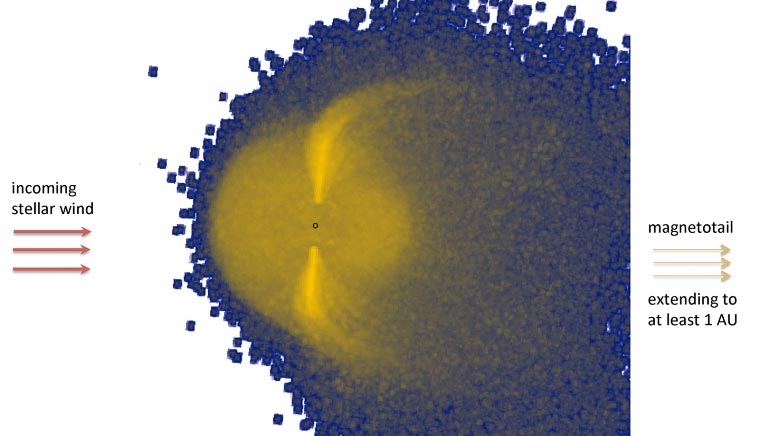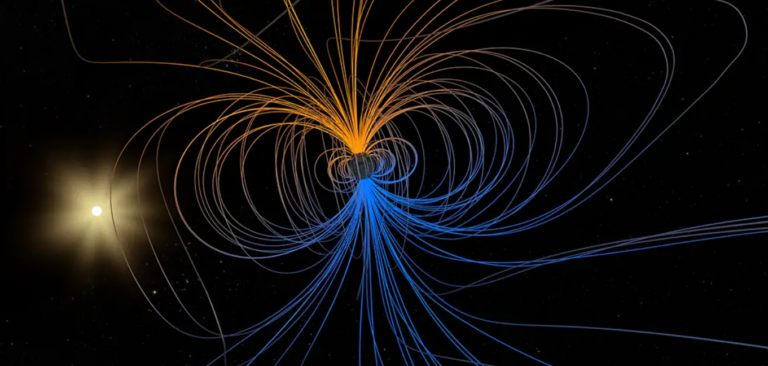Hubble has uncovered the initial proof of a magnetic field on an exoplanet
The international group of scientists was taking the data which was received by the Hubble Space Telescope into account and they somewhat confirmed the fact that there is the magnetic field in a distant planet. It is therefore the first case of a telescope showing such a phenomenon being observed on an exoplanet and the details are present in a report that was published in the journal Nature Astronomy.
The fact of neutral spectral lines at the length of 100 thousand km means that the magnetosphere as a magnetic field became widely recognized; it consists of charged carbon particles which swirl around the globe and stretch into a long tail. Understanding how to detect magnetic fields of exoplanets should be viewed as the milestone on the way to learning more about those mysterious distant worlds we cannot see since it is only magnetic field that protects a planetary atmosphere.
HAT-P-11b, an ice giant in our neighboring planetary system located at 123 light-years distance was observed by the astronomers using Hubble to study six “transit” configurations, where the Neptune-sized exoplanet was transiting straight across the face of its host star. The ultraviolet rays from the spectrum, comprising skies that lie just beyond human sight, is where the observations have been made.
The carbon ions in the planet were found to be charged and the magnetic reactions, within the planet’s magnetosphere, were discovered by Hubble. The geomagnetic environment surrounding a celestial body (e. g. the Earth) in the outer space, whose characteristics are due to the interaction of the object with the solar wind which comes from the star, is the magnetosphere.

Gilda Ballester, a co-author, research professor at University of Arizona Lunar and Planetary Laboratory, stated, “The magnetosphere of exoplanet was for the first time directly observed in the environment of an exoplanet that doesn’t orbit our own solar system. ” “Similar to Earth, a strong magnetic field can protect exoplanet’s atmosphere and surface from direct bombardmentSuch processes are several reasons for this evolution to life on planet Earth as the magnetic force shields organisms from ultra-energetic particles. ”
The observed existence of magnetosphere around HAT-P-11b is an important step towards characterizing an exoplanet, which is considered vital in its habitability (further explanation needed). The scientists express that not every celestial body in our solar system have magnetic field, and we still have to carry on doing research in this issue of the link between magnetic field and the habitability.
He went further to say that this technique that can be used to detect magnetospheres on different exoplanets and to determine whether they can potentially host life, if it has been applied to HAT-P-11 b was yet again very exciting, because ultraviolet observations by Hubble have detected a magnetosphere, seen as both the ion component that extends around the planet and a tail of escaping ions.
Ballester made an important contribution at this stage, as a principal investigator of the mission that studied the HAT-P-11b planet with the Hubble Space Telescope.
This finding of carbon ions in a tail that stretched out from the planet and closed at 100 mph, with an area surrounding it, was a remarkable outcome. A minimal distance of one astronomical unit (i. e. the distance between Earth and the sun) was reached by the tail after its venture into space.
Firstly, researchers at the Institute of Astrophysics in Paris as headed by Lotfi Ben-Jaffel modeled the interactions between the planet’s topmost atmospheric regions, magnetic field, and the incoming solar wind using 3D computer simulations.
“There exists interplay between HAT-P-11b’s magnetic field, alone with the interaction of the solar wind with its host star. These are very complex interactions, just like the earth’s magnetic field interacts with the solar wind, whose particles move approaching 900,000 mph,” Ballester said.
This exoplanet warms, and as a result, the fourth part of its atmosphere absorbing heat and escaping into space. Our atmosphere and that of HAT-P-11b are the same, because physics of their magnetospheres is identical. Result of this are the pointed tails.
Among other things, the researchers also found out that HAT-P-11b’s atmosphere metalicity was lower than predicted. The gas giant planets, Jupiter and Saturn, of our solar system have low abundance of metals in their atmosphere and have strong magnetic fields, while on the contrary, the ice gas giant planets, Neptune and Uranus, are rich in metals but have moderate magnetic fields. HAT-P-11b’s low level of atmospheric metallicity, according to the authors, surmounts the present models that explain how planets outside the Solar System have been formed.
The mass of HAT-P-11b is just 8% of that of Jupiter, however, we think that its structure looks like a mini-Jupiter more than it does Neptune,” Ballester said. “The research that we have conducted on the atmosphere of HAT-P-11b demonstrates that to be able to extend our understanding to the formation of other exoplanets in general we might.
Do not forget to share your opinion with us to provide you with the best posts !





0 Comments